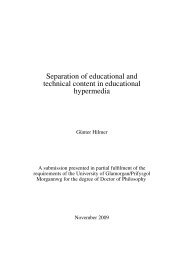framework for the implementation of a virtual design studio model in ...
framework for the implementation of a virtual design studio model in ...
framework for the implementation of a virtual design studio model in ...
You also want an ePaper? Increase the reach of your titles
YUMPU automatically turns print PDFs into web optimized ePapers that Google loves.
4.3.4 Design Curriculum<br />
Design courses are <strong>of</strong>fered from <strong>the</strong> second year to <strong>the</strong> f<strong>in</strong>al year <strong>in</strong> <strong>the</strong><br />
UAE architecture departments. While <strong>in</strong> <strong>the</strong> schools <strong>of</strong> architecture <strong>the</strong><br />
students start explor<strong>in</strong>g <strong>the</strong> <strong>design</strong> <strong>studio</strong> from <strong>the</strong>ir first year <strong>of</strong> study.<br />
The purpose <strong>of</strong> <strong>the</strong>se <strong>design</strong> courses is to give <strong>the</strong> students <strong>the</strong><br />
opportunity to experience real-life projects <strong>in</strong> <strong>the</strong>ir <strong>design</strong> practice. They<br />
also aim to give <strong>the</strong> students <strong>the</strong> technological skills needed <strong>for</strong> <strong>design</strong><br />
projects. It is also an opportunity <strong>for</strong> <strong>the</strong> student to practise hands-on<br />
what <strong>the</strong>y have learnt <strong>in</strong> <strong>the</strong> lecture room. In <strong>the</strong> UAE educational<br />
system <strong>the</strong>re are four <strong>design</strong> courses <strong>of</strong>fered to <strong>the</strong> student.<br />
In <strong>the</strong> UAE University <strong>the</strong> students undertake <strong>the</strong> first <strong>design</strong> <strong>studio</strong><br />
course upon jo<strong>in</strong><strong>in</strong>g <strong>the</strong> architecture department. This course aims to<br />
<strong>in</strong>troduce <strong>the</strong> student to <strong>the</strong> key concepts <strong>of</strong> architectural <strong>design</strong>. They<br />
are also <strong>in</strong>troduced to <strong>the</strong> primary s<strong>of</strong>tware that <strong>the</strong>y will be us<strong>in</strong>g <strong>in</strong> <strong>the</strong>ir<br />
future projects. In <strong>the</strong> second <strong>design</strong> <strong>studio</strong> course <strong>the</strong> students develop<br />
a set <strong>of</strong> relatively simple architectural projects; us<strong>in</strong>g <strong>for</strong>m and space as<br />
fundamental elements <strong>of</strong> architectural <strong>design</strong>. They also get <strong>the</strong><br />
opportunity <strong>for</strong> more hands on 2D and 3D visualisation s<strong>of</strong>tware such as<br />
AutoCAD. As <strong>the</strong> students progress <strong>in</strong> <strong>the</strong>ir studies <strong>the</strong>y encounter more<br />
complex architectural projects. They experiment with multiple pr<strong>in</strong>ciples<br />
<strong>of</strong> spatial organisations, such as central, l<strong>in</strong>ear, radial, modular, and<br />
clustered patterns. At later stages <strong>of</strong> <strong>the</strong>ir study, <strong>the</strong> students start <strong>the</strong>ir<br />
graduation projects. The first graduation project aims to engage <strong>the</strong><br />
students <strong>in</strong> real-life project. The projects are based on <strong>the</strong> real needs <strong>of</strong><br />
society. The students practice what <strong>the</strong>y learnt <strong>in</strong> <strong>the</strong> <strong>the</strong>ories and apply<br />
methods <strong>of</strong> architectural programm<strong>in</strong>g. The students also employ a<br />
contemporary architectural <strong>design</strong> criticism. They <strong>in</strong>itiate <strong>design</strong><br />
processes through research and <strong>design</strong> methods. At this course<br />
students also conduct a literature review, ga<strong>the</strong>r data, and analyse <strong>the</strong><br />
potential sites and similar exist<strong>in</strong>g build<strong>in</strong>gs. The emphasis is placed on<br />
physical and social documentation, visual survey<strong>in</strong>g, users‟ needs, and<br />
evaluation required <strong>for</strong> <strong>the</strong> project and programme preparation <strong>for</strong><br />
Graduation Project II course (Prerequisite). While <strong>the</strong> second graduation<br />
80



